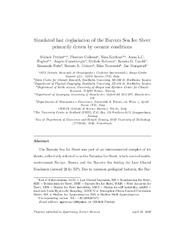Simulated last deglaciation of the Barents Sea Ice Sheet primarily driven by oceanic conditions
Permanent lenke
https://hdl.handle.net/10037/18932Dato
2020-05-19Type
Journal articleTidsskriftartikkel
Peer reviewed
Forfatter
Petrini, Michele; Colleoni, Florence; Kirchner, Nina; Hughes, Anna L.C.; Camerlenghi, Angelo; Rebesco, Michele; Lucchi, Renata Giulia; Forte, Emanuele; Colucci, Renato R.; Noormets, Riko; Mangerud, JanSammendrag
The Barents Sea Ice Sheet was part of an interconnected complex of ice sheets, collectively referred to as the Eurasian Ice Sheet, which covered north-westernmost Europe, Russia and the Barents Sea during the Last Glacial Maximum (around 21 ky BP). Due to common geological features, the Barents Sea component of this ice complex is seen as a paleo-analogue for the present-day West Antarctic Ice Sheet. Investigating key processes driving the last deglaciation of the Barents Sea Ice Sheet represents an important tool to interpret recent observations in Antarctica over the multi-millennial temporal scale of glaciological changes. We present results from a perturbed physics ensemble of ice sheet model simulations of the last deglaciation of the Barents Sea Ice Sheet, forced with transient atmospheric and oceanic conditions derived from AOGCM simulations. The ensemble of transient simulations is evaluated against the data-based DATED-1 reconstruction to construct minimum, maximum and average deglaciation scenarios. Despite a large model/data mismatch at the western and eastern ice sheet margins, the simulated and DATED-1 deglaciation scenarios agree well on the timing of the deglaciation of the central and northern Barents Sea. We find that the simulated deglaciation of the Barents Sea Ice Sheet is primarily driven by the oceanic forcing, with prescribed eustatic sea level rise amplifying the ice sheet sensitivity to sub-shelf melting over relatively short intervals. Our results highlight that the sub-shelf melting has a very strong control on the simulated grounding-line flux, showing that a slow, gradual ocean warming trend is capable of triggering sustained grounded ice discharge over multi-millennial timescales, even without taking into account marine ice sheet or ice cliff instability.
Forlag
ElsevierSitering
Petrini M, Colleoni F, Kirchner N, Hughes A.L.C., Camerlenghi A, Rebesco M, Lucchi RG, Forte E, Colucci RR, Noormets R, Mangerud J. Simulated last deglaciation of the Barents Sea Ice Sheet primarily driven by oceanic conditions. Quaternary Science Reviews. 2020;238:1-22Metadata
Vis full innførselSamlinger
Copyright 2020 The Author(s)


 English
English norsk
norsk